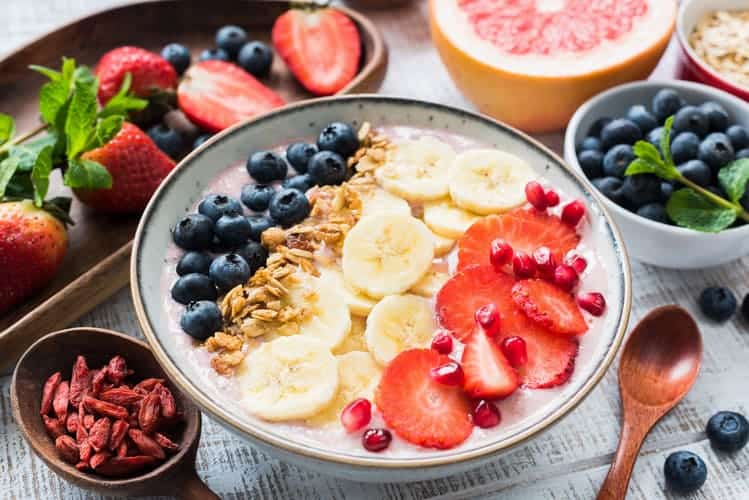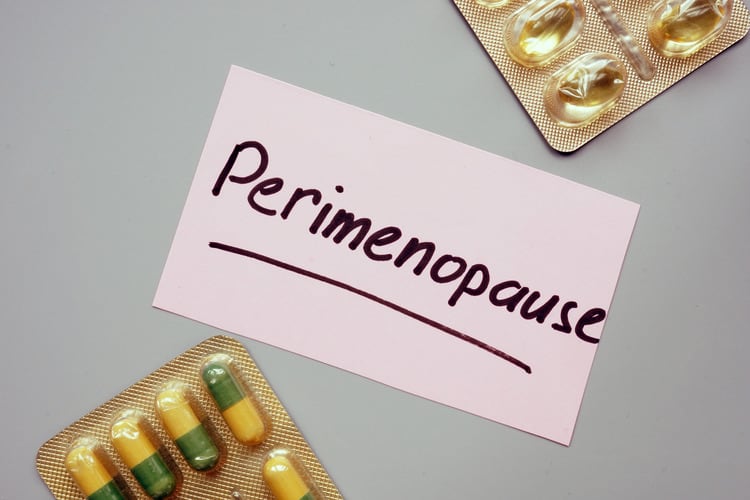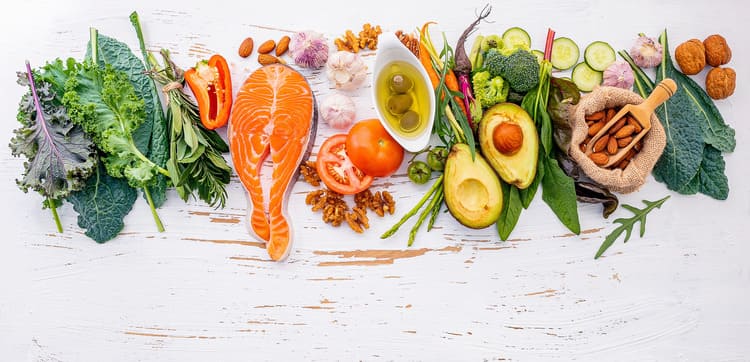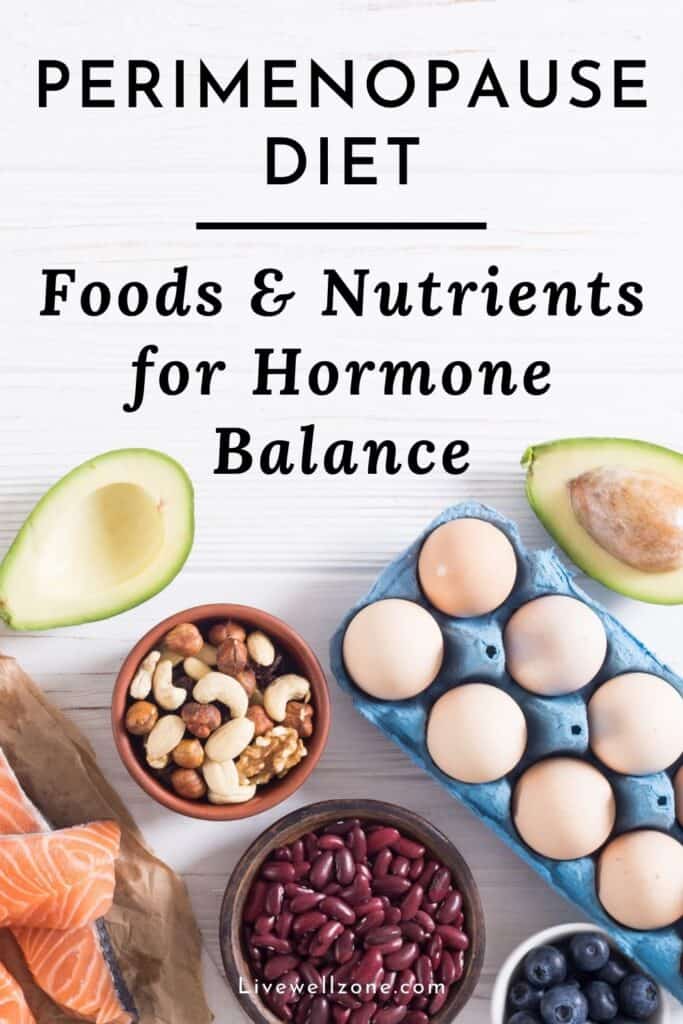
From weight gain and hot flashes, to fatigue and cycle changes, perimenopause is loaded with life-draining physical and emotional changes.
In addition, transitioning into menopause means increased concerns about osteoporosis, metabolic syndrome, cardiovascular complications and much more.
Now, while perimenopause symptoms are common, they are not normal.
Mother nature didn’t set out to make this time of life feel like a rapid descent into hell (even though, for many women, the experience is truly hellish).
You do not have to struggle through this time, just hoping and praying that you will feel better once menopause officially starts.
Who wants to wait that long to start enjoying life?!
As with all situations involving hormonal changes, food plays a key role in determining whether you sail through perimenopause (or struggle every step of the way).
So, in this article, we’re going to talk about the essentials of a perimenopause diet by looking at:
- The hormonal changes that occur during perimenopause (because it’s about so much more than just estrogen).
- The role that food plays in supporting your body.
- Foods to include – and avoid – in your perimenopause meal plans.
- Bonus tips to have success with your perimenopause diet.
Master your hormones in 5 days! Get The Balance and Bliss Blueprint, a FREE, 5-day email course that reveals the biggest mistakes that keep your hormones stuck (and what to do about it!). 👉 GET THE FREE EMAIL COURSE HERE 👈
Hormonal Changes During Perimenopause and Why Diet Matters

Most of the conversations around perimenopause focus a lot on estrogen and ignore two other important hormones: progesterone and cortisol.
Here’s why these two hormones can significantly impact your experience with perimenopause:
- Progesterone counterbalances estrogen. These two hormones must be within a certain ratio. If your progesterone is low for any reason, you can find yourself in a situation where estrogen dominates. Furthermore, progesterone is a calming hormone and plays a role in stabilizing our mood, alleviating PMS and helping us to process emotions.
- Cortisol goes up when we are stressed. The stress can come from family, career and or even, unhealthy diet (be it pesticide residue, not enough nutrients and more). In addition, the more stress you face, the more your blood sugar goes up, the more likely you are to face insulin resistance and the less progesterone you have (because more of your progesterone is used up to make cortisol).
- Nutrients get depleted when we’re stressed. The more stressful elements you have in your life, the more your body uses up your nutrients (in an attempt to fight off the damaging effects of stress). So it becomes even more important to eat healthy.
Overall, the combination of lower progesterone levels and potentially higher cortisol levels, can drive many of the symptoms associated with perimenopause, including:
- Weight gain.
- Vaginal dryness.
- Hot flashes.
- Mood swings.
- Irregular cycles and period imbalances (such as more intense PMS and heavy periods).
- Fatigue.
- Insomnia.
WHAT IS THE BEST DIET FOR PERIMENOPAUSE?

The painful truth is that there is no study that has been able to identify one perfect diet – be it keto, paleo, vegetarian and so on – for perimenopause.
In addition, with so many different diets popping up everyday, research dollars have not allocated to studying how each of them affects health during perimenopause.
When looking at the medical literature, the two studies that I came across most often were the Meditarranean Diet and DASH Diet.
1. Mediterranean Diet
Here’s some of the data on the Mediterranean diet and perimenopause:
- a study with 8,954 women (perimenopausal and postmenopausal) showed the Mediterranean Diet lowered the risk of becoming overweight (source).
- another study with 176 perimenopausal women showed a correlation between lower FM (fat mass) and adherence to the Mediterranean Diet (combined with higher consumption of whole-grains, nuts, fruits, pulses, whole dairy and olive oil).
- a 2020 review paper aimed at providing nutritional guidelines for weight management during menopause uses the Med Diet as its main focus and recommendation (source).
2. DASH Diet
The DASH (Dietary Approaches to Stop Hypertension) Diet was initially created to prevent or treat high blood pressure (source).
It is a nutrient-rich plan that emphasizes fruits, vegetables and whole grains, while limiting foods like fatty meats, full fat dairy, some oils and sweets.
Overall, some research indicates that provides relief for perimenopause symptoms (1, 2).
There are also health experts – like Mindy Pelz and Dr. Eric Berg – who recommend intermittent fasting and ketogenic eating respectively.
Now, regardless of the diet label – DASH, Mediterranean, Keto – the one thing that seems to be most helpful is adhering to a whole food diet, with minimal processed foods.
NOTE: personally an anti-inflammatory diet (which is simply a whole food, mostly plant-based diet) has been working well for me. You can learn more about why I personally like this way of eating and the foods that are included in this article.
PERIMENOPAUSE DIET PLAN: SCIENCE-BASED FOOD AND NUTRIENT LIST

In this section you will find a list of specific foods that are mentioned in scholarly articles as being beneficial during perimenopause. If you’d like to read through the studies and papers yourself, simply click the numbers at the end of this sentence (3, 4, 5, 6).
Please note that there isn’t really one specific food for weight loss and another food for hot flashes, etc.
Rather, studies show that a diet that includes the items listed below helps to improve various perimenopause symptoms.
1. Fiber
Good sources of fiber include:
- whole grains.
- vegetables.
- fruits.
- beans.
- dried fruit.
- nuts.
- seeds.
2. Vitamin D
There aren’t many foods that are naturally rich in vitamin D.
That said some mushrooms can have vitamin D (if they were grown in the wild or exposed to the appropriate UV light during cultivation).
In addition, fish oils and some fish (like tuna, swordfish and salmon) naturally contain vitamin D.
But that said, the best way to get sufficient vitamin D is from sun exposure or a good quality supplement (here’s my personal go-to vitamin D supplement).
3. Calcium
Some good food sources of calcium include:
- leafy greens.
- winter squash.
- dairy (preferably organic and fermented).
- edamame.
- almonds.
- figs
- oranges
- sardines
- salmon
4. Iron
Some foods that are rich in iron include:
- beef.
- poultry.
- dark leafy greens.
- beans
- eggs
- lentils
- dried fruits (like dates and raisins)
- blackstrap molasses
- seeds
- nuts
5. Phytoestrogens
In this category, soy is the most obvious choice. But actually, there are lots of foods that contain phytoestrogens, such as (source):
- fruits (cherries, peaches, apples, grapes and berries)
- flaxseeds.
- any fermented soy products (such as tempeh, miso, natto)
- beans
- sprouts
- grains
- garlic
- spinach
6. Whole Grains
When it comes to grains, there’s always some concern about gluten.
Gluten can be inflammatory for some women, so it’s up to you if you want to go gluten-free (temporarily or permanently).
Some grains to choose from:
- oats
- rice
- quinoa
- wheat
- buckwheat
- amaranth
- millet
- bulgur
- couscous
7. Nuts
Some common nuts to choose from are:
- almonds
- pecans
- macadamias
- walnuts
- cashews
- pine nuts
- hazelnuts
- Brazil nuts
8. Fruits
There are so many fruits to choose from that it’s probably not worth listing!
Just get your hands on any fresh fruit that is available to you.
If fresh isn’t always a viable option, then reach for frozen. They’re not exactly the same. For example, some nutrients, like inositol, are lower in frozen food (source).
But frozen is better than nothing!
9. Pulses
In the category of pulses, you can choose from:
- beans
- peas
- lentils
10. Whole Dairy
Even though some studies recommend whole dairy because they are calcium-rich, remember that dairy is also a common allergen/pro-inflammatory.
If you do move forward with dairy choose organic varieties and if possible, fermented.
Some foods to choose from:
- cheese
- butter (which you can also use to make ghee)
- yogurt.
11. Olive Oil
Of all the cooking oils, olive oil gets a special mention in research papers due to its anti-inflammatory, heart-friendly benefits.
For the best quality, look for organic, extra virgin olive oil.
Master your hormones in 5 days! Get The Balance and Bliss Blueprint, a FREE, 5-day email course that reveals the biggest mistakes that keep your hormones stuck (and what to do about it!). 👉 GET THE FREE EMAIL COURSE HERE 👈
FOODS TO AVOID DURING PERIMENOPAUSE
While anti-inflammatory foods help alleviate perimenopause symptoms, some foods exacerbate symptoms.
Here’s a list of some of the most common foods to avoid:
- Processed foods and drinks: Things like chips, crackers, pastries, soda and cookies often contain high levels of refined sugar and refined fats. These are highly inflammatory and can cause fluctuations in blood sugar levels.
- Coffee: While coffee isn’t inherently bad, it does stimulate the adrenals. If your adrenals are already working overtime, coffee can worsen things. Consider avoiding coffee for a while so that your body can bounce back as you eat healthier.
- Alcohol: your liver treats alcohol like an emergency. It has to take time to process and break down the alcohol. So, while it’s busy doing that, it’s not able to focus on clearing out other hormone-disrupting compounds and helping you maintain healthy hormone levels.
- Unfermented, Non-organic Dairy: conventional dairy – especially unfermented types – can be inflammatory and worsen symptoms like bloating. Consider switching to non-dairy alternatives such as almond or coconut milk.
- Red meat: unfortunately, red meat tends to be pro-inflammatory. Try to cut back your intake and opt for anti-inflammatory proteins instead (like plant proteins and fatty fish).
- Gluten: for some people, gluten can be inflammatory (even if you don’t have Celiac disease). Consider switching to gluten-free grains like quinoa, rice, and oats.
CONCLUSION
By focusing on nutrient-dense, anti-inflammatory foods, you can experience more ease and thrive during perimenopause.
Just remember that the changes you are making are meant to be long-term (not just a quick fix).
By developing these healthy habits during perimenopause, you’ll have an easier time when your body officially transitions into menopause and beyond.

You Might Also Like:
From Chaos to Calm: 7 Soothing Herbs for Menopause Mood Swings
Cool Off Naturally: 12 Powerful Herbs for Menopause Hot Flashes
Best Maca Supplement For Menopause
Everything You Need To Know About Estrogen Dominance During Perimenopause

